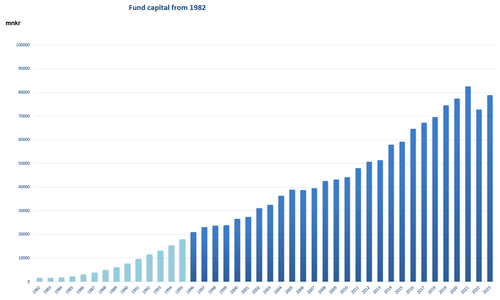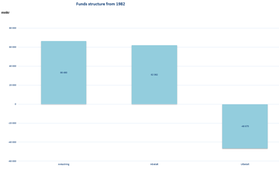History
Structure of Fund
The Nuclear Waste Fund was started in 1982. During the first fourteen years, the fees were deposited in an interest-bearing account at Riksbanken (the Swedish central bank). The current asset management model giving the Nuclear Waste Fund responsibility as asset manager was introduced in 1996. At first, the Nuclear Waste Fund fulfilled its responsibility by making deposits in an account at the National Debt Office. This model was changed in 2002 to investments on the market for Swedish treasury bonds and treasury bills. In 2009, the investment options were broadened to include covered mortgage bonds. Starting in 2018, the Nuclear Waste Fund was also allowed, within certain limits, to invest in more risky assets such as equities and corporate bonds, as well as and in derivatives.
The size of the Fund at the end of each year since the start in 1982 is shown in the following graph. The light blue bars show the years when the fees were deposited in an interest-bearing account at Riksbanken.
 Förstora bilden
Förstora bildenKlicka för större version
Distribution of Fund capital per payer
The paid-in fees are earmarked for each payer and may only be used to cover the costs attributable to that particular payer. Joint costs are allocated among the fee-liable licensees.
Since the start in 1982, the fee-liable reactor owners are Forsmarks Kraftgrupp AB, OKG AB (Oskarshamn), Ringhals AB and Barsebäck Kraft AB. Since 2010, other fee-liable licensees also pay fees to the Fund. The other fee-liable licensees are Chalmers Tekniska Högskola AB, Westinghouse Electric AB, Vattenfall AB Ågesta, Ranstad Mineral AB, Cyclife Sweden AB and Studsvik Nuclear AB.
If the paid-in fees for a reactor owner or other fee-liable licensee should not suffice to cover the payer’s costs, fees paid in by another reactor owner may not be used to make up the difference. If Fund assets are left over for a fee-liable licensee after all costs relating to that fee-liable licensee have been paid, these surplus fees must be paid back to the payer.
Fees paid in pursuant to the Studsvik Act are also managed in the Nuclear Waste Fund. Up until 2017, the nuclear power-producing companies paid a special fee to finance the decommissioning of the research reactors in Studsvik and certain other costs for the early Swedish nuclear power programme. This repayment obligation does not apply to Studsvik fees, however. Any surplus Studsvik fees in the Fund go to the state.
The funds structure from 1982.
 Förstora bilden
Förstora bildenKlicka för större version
Kärnavfallsfonden, c/o Kammarkollegiet, Box 2218, 103 15 Stockholm, Tel: 08-700 08 00, E-post: karnavfallsfonden@kammarkollegiet.se
